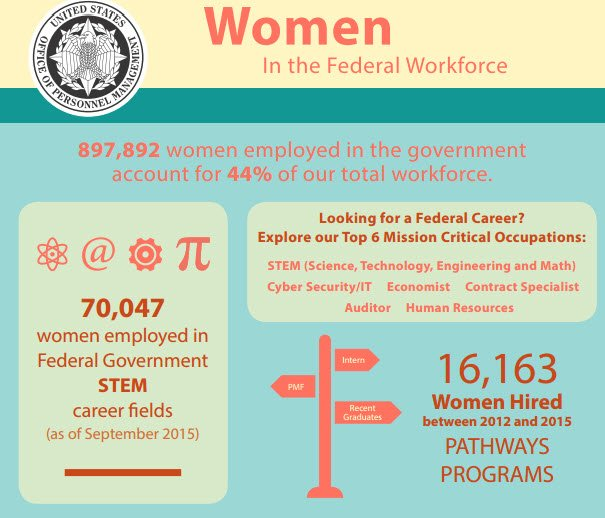ATD Blog
State of Federal Women Workforce
Fri Jun 24 2016

According to the U.S. Office of Personnel Management, 897,892 women work for the federal government, making up 44 percent of the entire federal workforce. “Women are succeeding across government—from entry-level positions to various leadership roles,” says OPM Acting Director Beth Cobert on the OPM blog.
According to data compiled by OPM, the representation of women in the Senior Executive Service (SES), the federal government’s highest career level, increased by five percent between 2008 and 2015. And OPM is working with agencies across government to increase awareness of leadership development programs like “Executive Women in Motion” and other mentoring and training opportunities.
In addition, women have been hired at an increasing rate into the Pathways Programs, including the Presidential Management Fellows (PMF) programs. The PMF is the federal government’s flagship leadership development program, which has a special STEM track. In fact, the number of federal women working in STEM (science, technology, engineering, and mathematics) fields is on the rise. In 2008, 64,574 were working in federal STEM jobs; that number rose to 70,047 in 2015.
“By creating opportunities at every level of the workforce, we are working to attract, empower, and retain a talented and productive workforce,” says Cobert.
The data also shows that the gender pay gap in the federal government continues to narrow. In 2014, nationally, women were paid 79 cents for every dollar a man was paid. In 2015, across the federal government, women in white-collar jobs were paid 89 cents on the dollar. With more women than ever contributing to the government’s mission critical occupations, the gender pay gap continues to narrow even more for women working in STEM, IT/cyber security, economist, auditor, contract specialist, and human resources positions jobs. In the Senior Executive Service, as of 2015, women were paid equally with their male counterparts.
In addition to pay and advancement opportunities, flexible schedules, telework options, and work-life balance programs are other key factors to attracting and retaining women workers. And data from the Federal Employee Viewpoint Survey (FEVS) shows that satisfaction with federal work-life programs is very high among women who participate in such programs. “Our commitment to workplace flexibilities and employee wellness makes the federal service an ideal place for employees to build their careers and cultivate fulfilling lives outside the workplace,” says Cobert.
For more data on the state of women working in the federal workforce, check out a new infographic from OPM.
You've Reached ATD Member-only Content
Become an ATD member to continue
Already a member?Sign In
